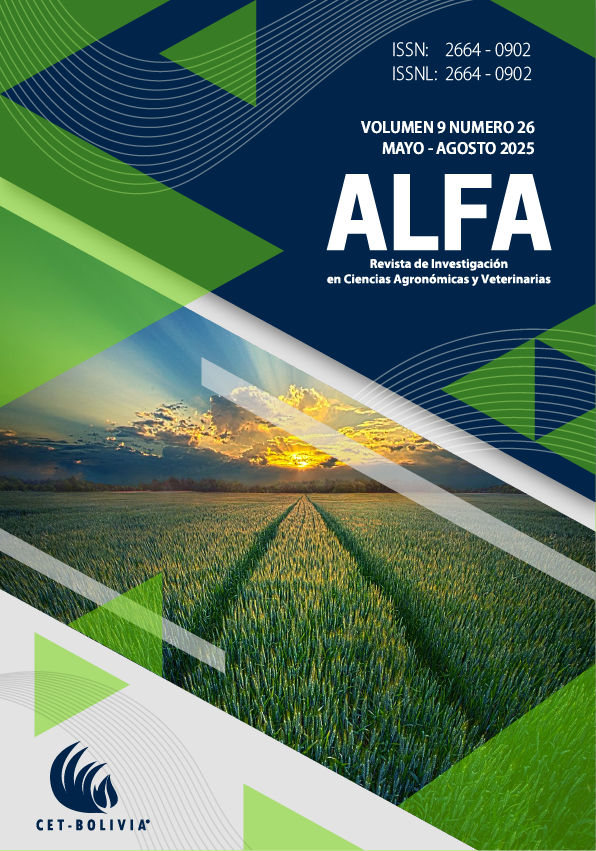Impacto del tráfico de fauna silvestre en Ecuador y su relación con la sostenibilidad
Impact of wildlife trafficking in Ecuador and its relationship with sustainabilityContenido principal del artículo
El tráfico ilegal de fauna silvestre constituye una de las principales amenazas para la biodiversidad en Ecuador, un país reconocido por su alta diversidad biológica que se ha convertido en un punto crítico para este comercio ilícito, lo que afecta no solo a las especies, sino también a los ecosistemas y la salud pública. El presente estudio, de tipo descriptivo con enfoque cuantitativo, tuvo como objetivo analizar el impacto del tráfico de fauna en el Centro de Paso de la Universidad Agraria del Ecuador. Para ello, se recopilaron y analizaron datos de 130 especímenes pertenecientes a 15 especies, con predominancia de reptiles, al evaluar variables como estado de conservación, procedencia, edad y salud. Los resultados mostraron que la familia Kinosternidae fue la más afectada, y representa el 61% de los especímenes, siendo la mayoría adultos y machos. Al egresar, el 92,86% de los animales se encontraba en buen estado de salud, lo que refleja la eficacia del centro en la rehabilitación. Sin embargo, estos hallazgos evidencian la urgente necesidad de implementar estrategias integrales de conservación y fortalecer la colaboración interinstitucional para enfrentar el tráfico ilegal y preservar la biodiversidad ecuatoriana, donde se considera además los impactos sociales, ecológicos y sanitarios asociados a esta problemática.
Illegal wildlife trafficking constitutes one of the main threats to biodiversity in Ecuador, a country recognized for its high biological diversity that has become a critical point for this illicit trade, affecting not only species, but also ecosystems and public health. The present study, of a descriptive type with quantitative approach, aimed to analyze the impact of fauna traffic on the Paso Center of the Agrarian University of Ecuador. To do this, data from 130 specimens belonging to 15 species were collected and analyzed, with predominance of reptiles, evaluating variables such as conservation, origin, age and health. The results showed that the Kinostidae family was the most affected, representing 61% of the specimens, the majority being adults and males. By graduating, 92.86% of animals were in good health, reflecting the effectiveness of the center in rehabilitation. However, these findings show the urgent need to implement comprehensive conservation strategies and strengthen inter -institutional collaboration to face illegal traffic and preserve Ecuadorian biodiversity, also considering the social, ecological and health impacts associated with this problem.
Descargas
Detalles del artículo
Harfoot B, Johnston A, Balmford A, Burgess N, Butchart H, Stuart SN. Using the IUCN Red List to map threats to terrestrial vertebrates at global scale. Nat Ecol Evol. 2021; 5:1510–9. https://doi.org/10.1038/s41559-021-01542-9
Tirira D. La conservación de mamíferos en el Ecuador. Mammalia Aequatorialis. 2021;3: 7-8. https://doi.org/10.59763/mam.aeq.v3i.43
Richards R, Emen M, Rugel O. Condiciones de la fauna silvestre de tráfico ilegal en un centro de rescate en la ciudad de Guayaquil, Ecuador. Rev Investig Vet Perú. 2021;32(6). http://dx.doi.org/10.15381/rivep.v32i6.20377
Naciones Unidas. Objetivos de Desarrollo Sostenible (ODS). 2015 https://sdgs.un.org/goals
UNEP-WCMC. The world’s wildlife trade: Towards a sustainable future. United Nations Environment Programme. 2020. https://www.unep-wcmc.org/
González Salas R, Vidal M, Jiménez M, Villamarín D. Gestión de áreas protegidas en el Ecuador: estrategias y conservación. Rev Univ Soc. 2024;16(4):160–9. https://n9.cl/y8ui4n
Sinovas P, Price B. Ecuador´s Wildlife Trade. Quito, Ecuador: UNEP-WCMC. 2015. https://n9.cl/tn4ks4
Mendoza-Montesdeoca I, Rivera-Mateos M, Doumet-Chilán N. Políticas públicas ambientales y desarrollo turístico sostenible en las áreas protegidas de Ecuador. Rev Estud Andal. 2022;(43):106–24. https://doi.org/10.12795/rea.2022.i43.06
Tamayo-Vásquez F, Pascumal-Luna R, Maisanche-Tomarima D. El principio de sustentabilidad en el Ecuador. Tejedora. 2021 ;4(8):202–16. https://n9.cl/ubazod
Lavorgna A. Wildlife trafficking in the Internet age. Crime Sci. 2014;3(5):1–12. https://doi.org/10.1186/s40163-014-0005-2
Nijman V. An overview of international wildlife trade from Southeast Asia. Biodivers Conserv. 2010; 19:1101–14. https://doi.org/10.1007/s10531-009-9758-4.
Pires S, Moreto W. The illegal wildlife trade. En: Oxford Handbook Topics in Criminology and Criminal Justice. Oxford University Press. 2012. https://doi.org/10.1093/oxfordhb/9780199935383.013.161
Parry L, Barlow J, Peres C. Hunting for Sustainability in Tropical Secondary Forests. Conserv Biol. 2009;23(5):1270–80. https://doi.org/10.1111/j.1523-1739.2009.01224.x [^
Daszak P, Cunningham A, Hyatt A. Emerging infectious diseases of wildlife–Threats to biodiversity and human health. Science. 2000;287(5452):443–9. https://doi.org/10.1126/science.287.5452.443.
Reuter A, Kunen J, Roberton S. Averting a crisis: Wildlife trafficking in Latin America. Wildlife Conservation Society. 2018. https://n9.cl/px1hr
Ministerio del Ambiente. Política Nacional para la Gestión de la Vida Silvestre. Quito, Ecuador. 2017. https://n9.cl/sz4ru
United Nations Environment Programme (UNEP). 2022 Global Status Report for Buildings and Construction. Global Alliance for Buildings and Construction. 2022, https://n9.cl/0bizy
Crespo-Gascón S, Solórzano C, Guerrero-Casado J. El tráfico nacional de fauna silvestre incluye especies amenazadas: Un estudio descriptivo en Manabí (Ecuador). La Granja. 2022;35(1):33–44. https://n9.cl/1twqq
Rosen G, Smith K. Summarizing the evidence on the international trade in illegal wildlife. EcoHealth. 2010;7(1):24–32. https://doi.org/10.1007/s10393-010-0317-y.
Shepherd C, Magnus N. Nowhere to hide: the trade in Sumatran tiger. TRAFFIC Southeast Asia. 2004. https://n9.cl/bycky
Wyatt T. Wildlife Trafficking, A Deconstruction of the Crime, Victims and Offenders. Springer Nature. 2022. https://doi.org/10.1007/978-3-030-83753-2.
Zhang L, Hua N, Sun S. Wildlife trade, consumption and conservation awareness in southwest China. Biodivers Conserv. 2008;17(6):1493–516. https://doi.org/10.1007/s10531-008-9358-8.
Zhou Z, Jiang Z. International Trade Status and Crisis for Snake Species in China. Conserv Biol. 2004;18(5):1386–94. https://doi.org/10.1111/j.1523-1739.2004.00293.x.
Sollund R. The Crimes of Wildlife Trafficking: Issues of Justice, Legality and Morality. Routledge; 2019. https://doi.org/10.4324/9781315550428.

